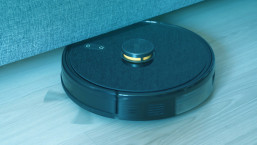There is a certain singularity to CES (Consumer Electronics Show), where vehicles, security, and a host of other technologic doodads unite around a given platform, in this case the car. As these converge, they’re redefining transportation, and even what “automobile” itself means.
Think mobile living room, not car. Interior designers are rethinking what you’ll do in the car once you stop driving one and become a passenger more concerned with ambient lighting and comfy seats that massage you for the full experience on the way to the office. Speaking of the office, your car will be your office too – that just happens to move.
Even the larger automobile manufacturers are spinning off startups that are set to reimagine peaceful serenity in an automotive-looking box that glides down the road. And when CES supplants the Detroit Auto Show as the premier car show (which arguably it already has), technology truly will become king of the road.
It’s not just the interior. There are a bevy of sensor-housing appendages hanging off all things automotive to check the weather, pedestrian traffic and where you’ll eat for lunch.
How will it all stay secure? Security-focused companies here are starting to get traction, imagining firewalls, packet snooping, AI cores and security scans bolted onto the various networks in the modern car, some even connected to the cloud for extra horsepower dedicated to the security workload.
But car security will still be hard. Unlike developing a new laptop, it takes many years to bring a new car model to market and into the showroom where you can buy one with all this security (hopefully) baked in. Meanwhile, software will rapidly outpace the state of the art at the time the car was designed.
How will the software be updated? I bought a new car a couple of years ago, and it came with an in-dash infotainment system, which apparently needs an update that I have to pay for. I know I should update immediately, but I haven’t because it’s not convenient, and I’m used to software automatically updating itself behind the scenes.
And it won’t just be your car that’s a mobile compute platform: everything from trucking to shipping to where your child is on a bicycle at any given time – these will be part of the fray. From commercial to warehouse to autonomous everything, CES is rethinking transportation writ large.
Again, how will it all stay secure? Welcome an old friend: Linux. While there is a tension between open and closed source, collaborating through The Linux Foundation to provide Automotive Grade Linux (AGL) seems like a good way to get the players on the same page. At least one very large car manufacturer has already integrated the technology into its cars, so it seems ready to deploy.
There’s even a series of penetration testing toolkits to help automobile system designers understand where the systems they develop might have vulnerabilities.
What does the future hold? Where will the jobs go when everything in the automotive industry – including driving the cars once the robots get them built – becomes automated?
If the decades at CES have taught us anything, it’s that the new killer app will be coming soon, and while the kinds of jobs we do in the future may change, the visionaries here will still gather to bask in the optimistic techno-glow that is CES.




